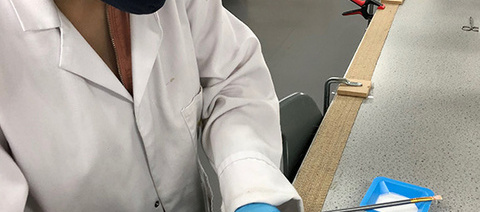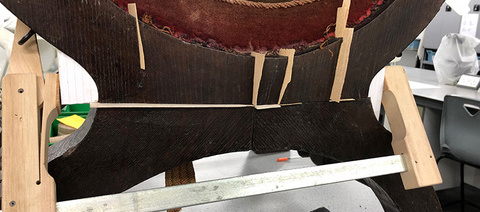Oak X-Chair C19th
Conservation treatment of a two piece C19th X-chair involving structural repair of the frame and upholstery repair of textile seat. Degradation to various components of the chair, affecting its stability and appearance were identified and suitable treatment was carried out in protection of the object’s values. The following treatment aims were identified and achieved:
• Stabilising the lower frame and upholstery
• Re-attachment of lion head plant-on
• Ensuring the historic, commemorative, and aesthetic values were not compromised
• Treated to standard suitable for temporary display
What was the goal the project set out to achieve?
The main treatment aim was to ensure the chair would be stable for display and storage. To that end the base of the upholstery which had torn away and allowed the internal stuffing to become loose needed to be secured, with significant tears on the seat also needing to be addressed. The stability of the frame was not conducive for moving between storage and display and a loose lion head plant-on required reattaching. General cleaning was also required.
Documentation including visual and written records were carried out, as well as COSHH and risk assessments. This involved a treatment proposal, report and laboratory card.
What did I do?
Appropriate safety measures were followed upon discovering the object contained trace amounts of arsenic across both material types.
General cleaning involved mechanical and solvent methods. Soft bristle brushes and a low powered vacuum cleaner removed the loose dirt and dust. After solvent testing, water and white spirit were used to clean built-up dirt and grime on the surface of the frame. Cleaning was required at several stages of the treatment.
To secure the upholstery base, new webbing straps were constructed with wood clamps made to hold these strap to the frame with a traditional adhesive so damage wouldn't be incurred from the use of upholstery nails, whilst ensuring the original webbing straps which were torn and degraded were not lost. The seat tears were addressed with a protective layer of cotton, followed by several layers of colour matched netting to reproduce the multicoloured appearance achieved by the original velvet.
The frame required gap-filling to stabilise. Balsa wood and oak veneer were used with traditional adhesive. These pieces were carved to be flush with the original surface, sanded and painted with acrylics to match the finish of the chair. Wax stopper was used for the remaining small gaps. The loose lion head plant-on required new dowels made from cocktail sticks, and traditional adhesive to secure back to the front of the frame.
What was the outcome?
A successful treatment ensured the chair was stable for museum display, storage and moving. The internal stuffing of the upholstery was now secured so no further loss occurred, and the stabilised frame ensured there would be no loss of the previously separated pieces and movement of the chair would not exacerbate damage.
What did I learn?
The treatment of the x-chair was a lesson in adaptivity in addressing multiple stability issues at once, and being able to prioritise the most significant issues.
Working on an object constructed of multiple materials including wood, textiles and metal meant considering how treatment of one could affect the others. Interventive treatment was a necessity for stabilising the object for display and required cleaning, gap-filling and colour matching of all material types.


